Anoxia and the Physiological Response of the Body or Cell: Analysis
VerifiedAdded on 2022/10/17
|11
|2477
|321
Report
AI Summary
This report provides a comprehensive overview of anoxia, the condition of oxygen deprivation, and its detrimental effects on organisms. It explores the physiological processes involved and the various response and feedback mechanisms employed by cells and the body to counteract anoxia. The report discusses the role of factors such as Heat Shock Proteins (HSPs), Unfolded Protein Response (UPR), FOX and P53 genes, and NF-κB in regulating cellular responses and promoting survival under anoxic conditions. Furthermore, it highlights the impact of anoxia on glycolysis and other metabolic pathways, using examples like the naked mole-rat. The report concludes by summarizing the importance of these regulatory mechanisms in mitigating the negative consequences of anoxia, emphasizing the intricate interplay of various factors in maintaining cellular and organismal homeostasis.
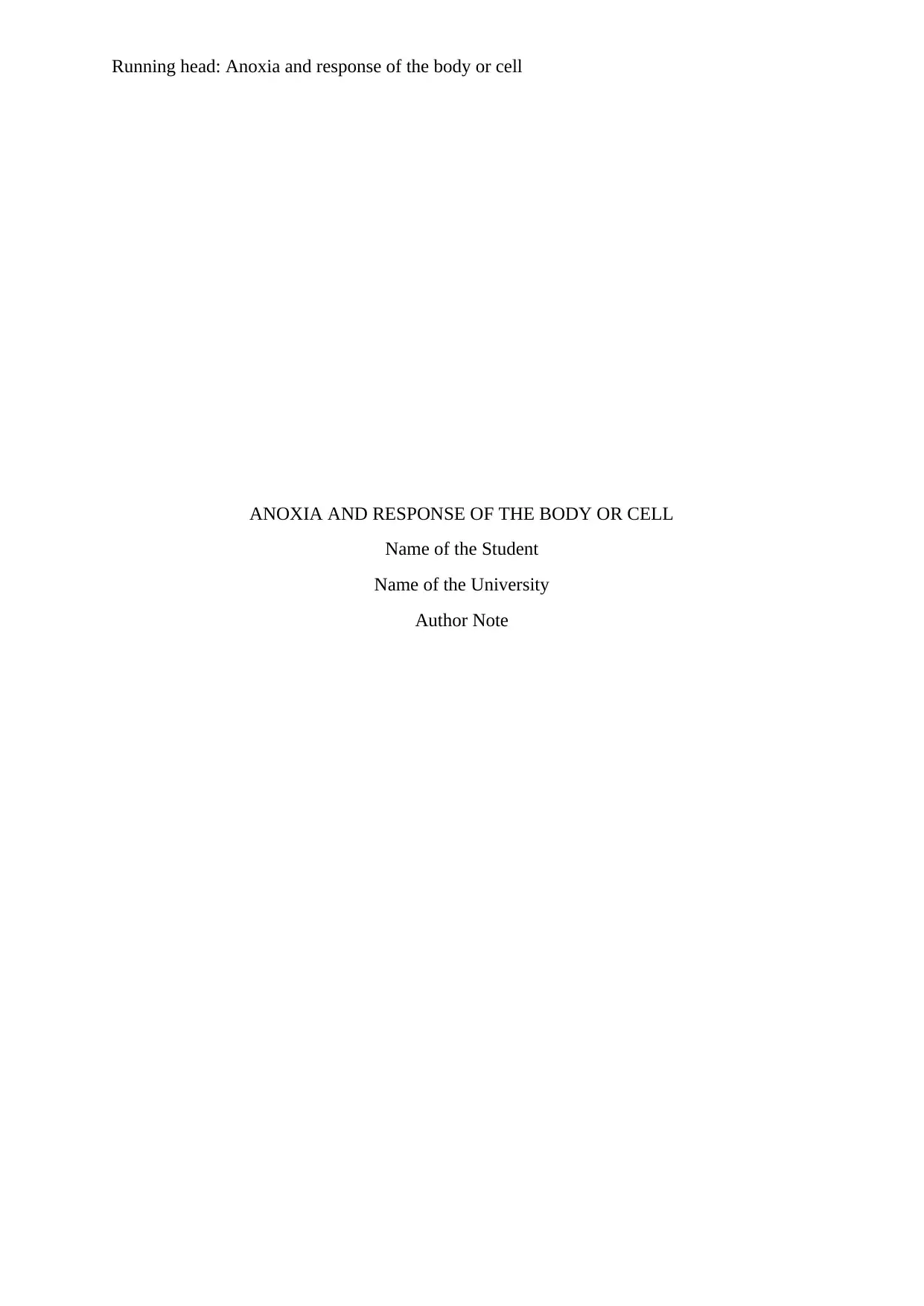
Running head: Anoxia and response of the body or cell
ANOXIA AND RESPONSE OF THE BODY OR CELL
Name of the Student
Name of the University
Author Note
ANOXIA AND RESPONSE OF THE BODY OR CELL
Name of the Student
Name of the University
Author Note
Paraphrase This Document
Need a fresh take? Get an instant paraphrase of this document with our AI Paraphraser
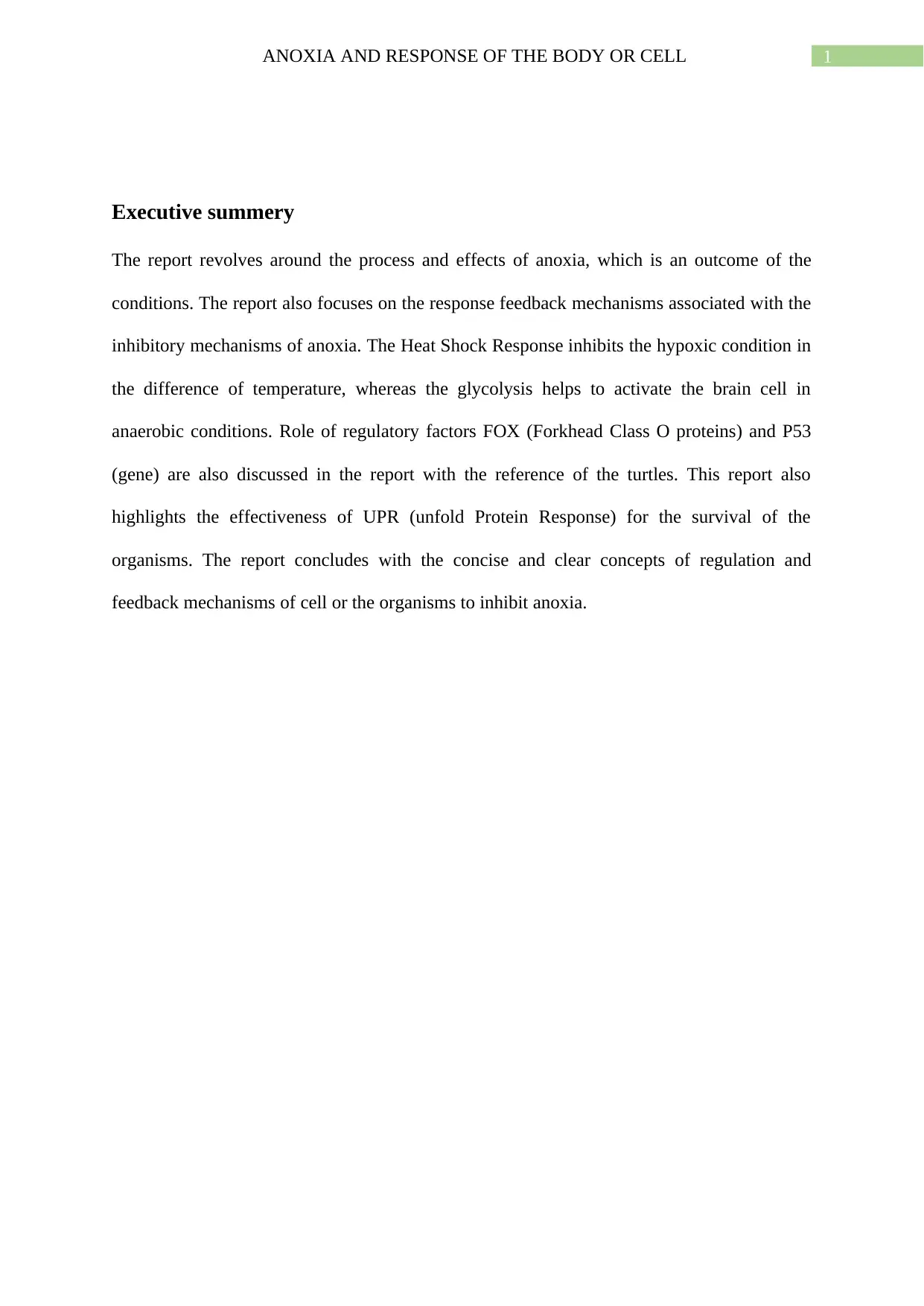
1ANOXIA AND RESPONSE OF THE BODY OR CELL
Executive summery
The report revolves around the process and effects of anoxia, which is an outcome of the
conditions. The report also focuses on the response feedback mechanisms associated with the
inhibitory mechanisms of anoxia. The Heat Shock Response inhibits the hypoxic condition in
the difference of temperature, whereas the glycolysis helps to activate the brain cell in
anaerobic conditions. Role of regulatory factors FOX (Forkhead Class O proteins) and P53
(gene) are also discussed in the report with the reference of the turtles. This report also
highlights the effectiveness of UPR (unfold Protein Response) for the survival of the
organisms. The report concludes with the concise and clear concepts of regulation and
feedback mechanisms of cell or the organisms to inhibit anoxia.
Executive summery
The report revolves around the process and effects of anoxia, which is an outcome of the
conditions. The report also focuses on the response feedback mechanisms associated with the
inhibitory mechanisms of anoxia. The Heat Shock Response inhibits the hypoxic condition in
the difference of temperature, whereas the glycolysis helps to activate the brain cell in
anaerobic conditions. Role of regulatory factors FOX (Forkhead Class O proteins) and P53
(gene) are also discussed in the report with the reference of the turtles. This report also
highlights the effectiveness of UPR (unfold Protein Response) for the survival of the
organisms. The report concludes with the concise and clear concepts of regulation and
feedback mechanisms of cell or the organisms to inhibit anoxia.
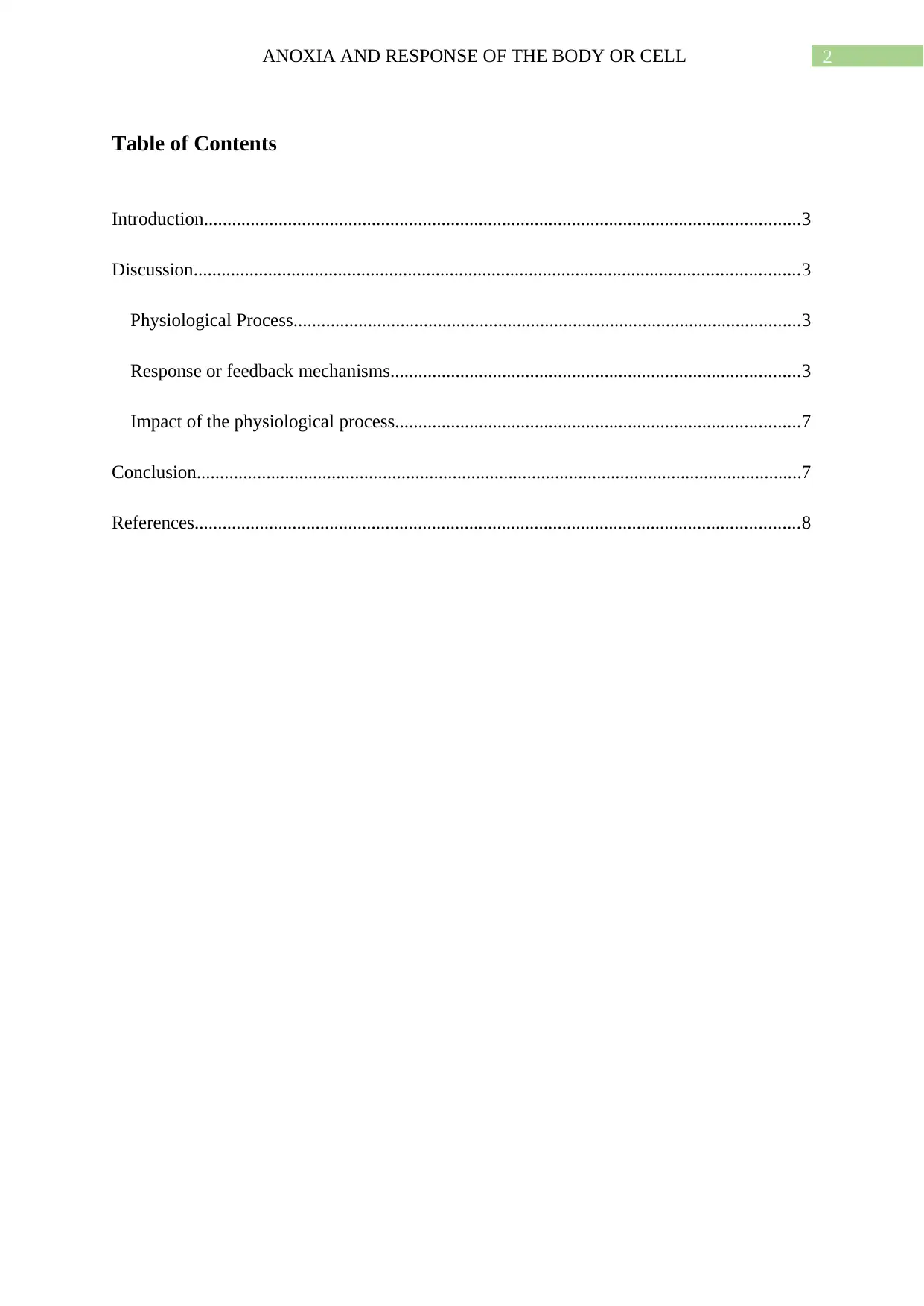
2ANOXIA AND RESPONSE OF THE BODY OR CELL
Table of Contents
Introduction................................................................................................................................3
Discussion..................................................................................................................................3
Physiological Process.............................................................................................................3
Response or feedback mechanisms........................................................................................3
Impact of the physiological process.......................................................................................7
Conclusion..................................................................................................................................7
References..................................................................................................................................8
Table of Contents
Introduction................................................................................................................................3
Discussion..................................................................................................................................3
Physiological Process.............................................................................................................3
Response or feedback mechanisms........................................................................................3
Impact of the physiological process.......................................................................................7
Conclusion..................................................................................................................................7
References..................................................................................................................................8
⊘ This is a preview!⊘
Do you want full access?
Subscribe today to unlock all pages.

Trusted by 1+ million students worldwide
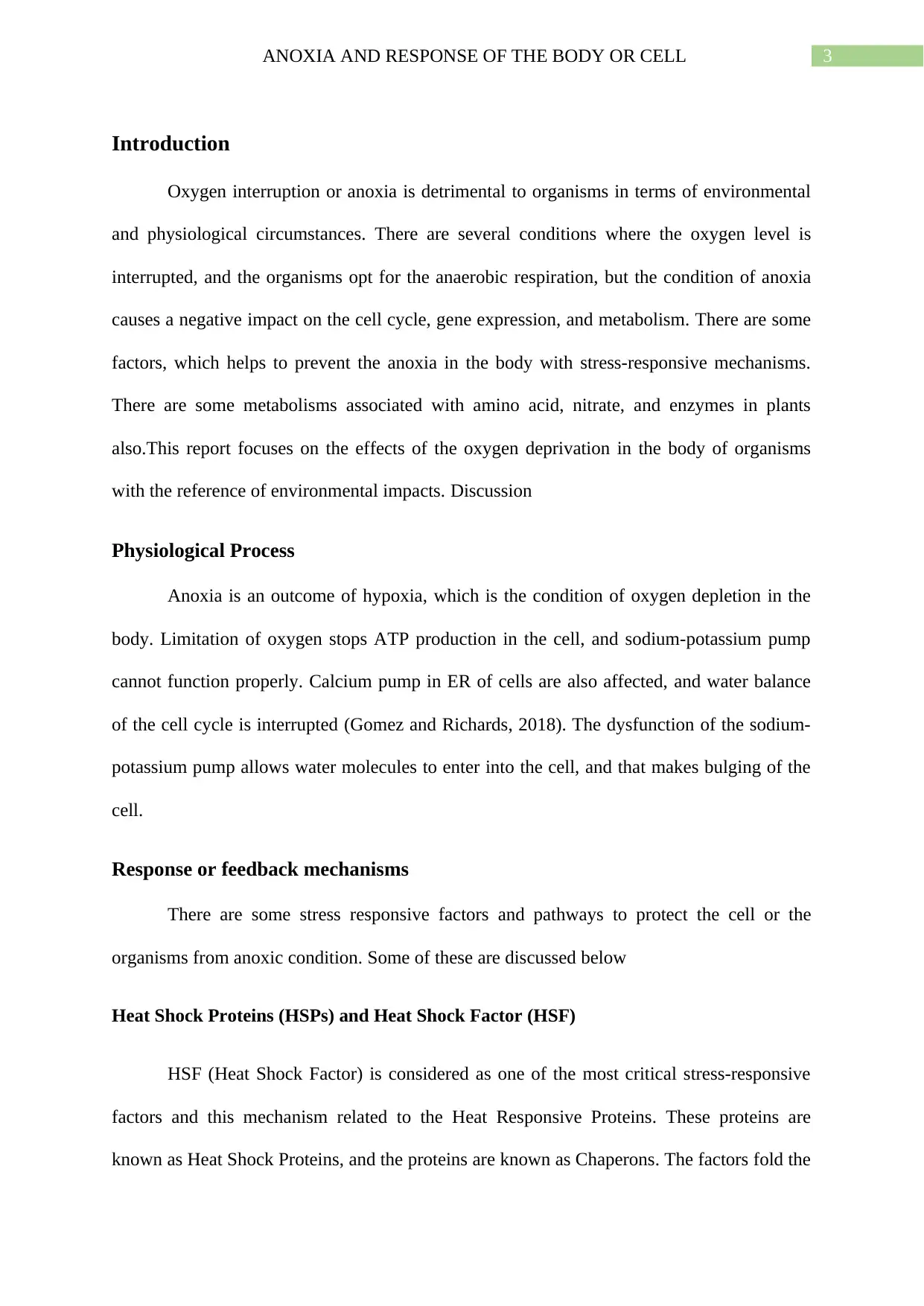
3ANOXIA AND RESPONSE OF THE BODY OR CELL
Introduction
Oxygen interruption or anoxia is detrimental to organisms in terms of environmental
and physiological circumstances. There are several conditions where the oxygen level is
interrupted, and the organisms opt for the anaerobic respiration, but the condition of anoxia
causes a negative impact on the cell cycle, gene expression, and metabolism. There are some
factors, which helps to prevent the anoxia in the body with stress-responsive mechanisms.
There are some metabolisms associated with amino acid, nitrate, and enzymes in plants
also.This report focuses on the effects of the oxygen deprivation in the body of organisms
with the reference of environmental impacts. Discussion
Physiological Process
Anoxia is an outcome of hypoxia, which is the condition of oxygen depletion in the
body. Limitation of oxygen stops ATP production in the cell, and sodium-potassium pump
cannot function properly. Calcium pump in ER of cells are also affected, and water balance
of the cell cycle is interrupted (Gomez and Richards, 2018). The dysfunction of the sodium-
potassium pump allows water molecules to enter into the cell, and that makes bulging of the
cell.
Response or feedback mechanisms
There are some stress responsive factors and pathways to protect the cell or the
organisms from anoxic condition. Some of these are discussed below
Heat Shock Proteins (HSPs) and Heat Shock Factor (HSF)
HSF (Heat Shock Factor) is considered as one of the most critical stress-responsive
factors and this mechanism related to the Heat Responsive Proteins. These proteins are
known as Heat Shock Proteins, and the proteins are known as Chaperons. The factors fold the
Introduction
Oxygen interruption or anoxia is detrimental to organisms in terms of environmental
and physiological circumstances. There are several conditions where the oxygen level is
interrupted, and the organisms opt for the anaerobic respiration, but the condition of anoxia
causes a negative impact on the cell cycle, gene expression, and metabolism. There are some
factors, which helps to prevent the anoxia in the body with stress-responsive mechanisms.
There are some metabolisms associated with amino acid, nitrate, and enzymes in plants
also.This report focuses on the effects of the oxygen deprivation in the body of organisms
with the reference of environmental impacts. Discussion
Physiological Process
Anoxia is an outcome of hypoxia, which is the condition of oxygen depletion in the
body. Limitation of oxygen stops ATP production in the cell, and sodium-potassium pump
cannot function properly. Calcium pump in ER of cells are also affected, and water balance
of the cell cycle is interrupted (Gomez and Richards, 2018). The dysfunction of the sodium-
potassium pump allows water molecules to enter into the cell, and that makes bulging of the
cell.
Response or feedback mechanisms
There are some stress responsive factors and pathways to protect the cell or the
organisms from anoxic condition. Some of these are discussed below
Heat Shock Proteins (HSPs) and Heat Shock Factor (HSF)
HSF (Heat Shock Factor) is considered as one of the most critical stress-responsive
factors and this mechanism related to the Heat Responsive Proteins. These proteins are
known as Heat Shock Proteins, and the proteins are known as Chaperons. The factors fold the
Paraphrase This Document
Need a fresh take? Get an instant paraphrase of this document with our AI Paraphraser
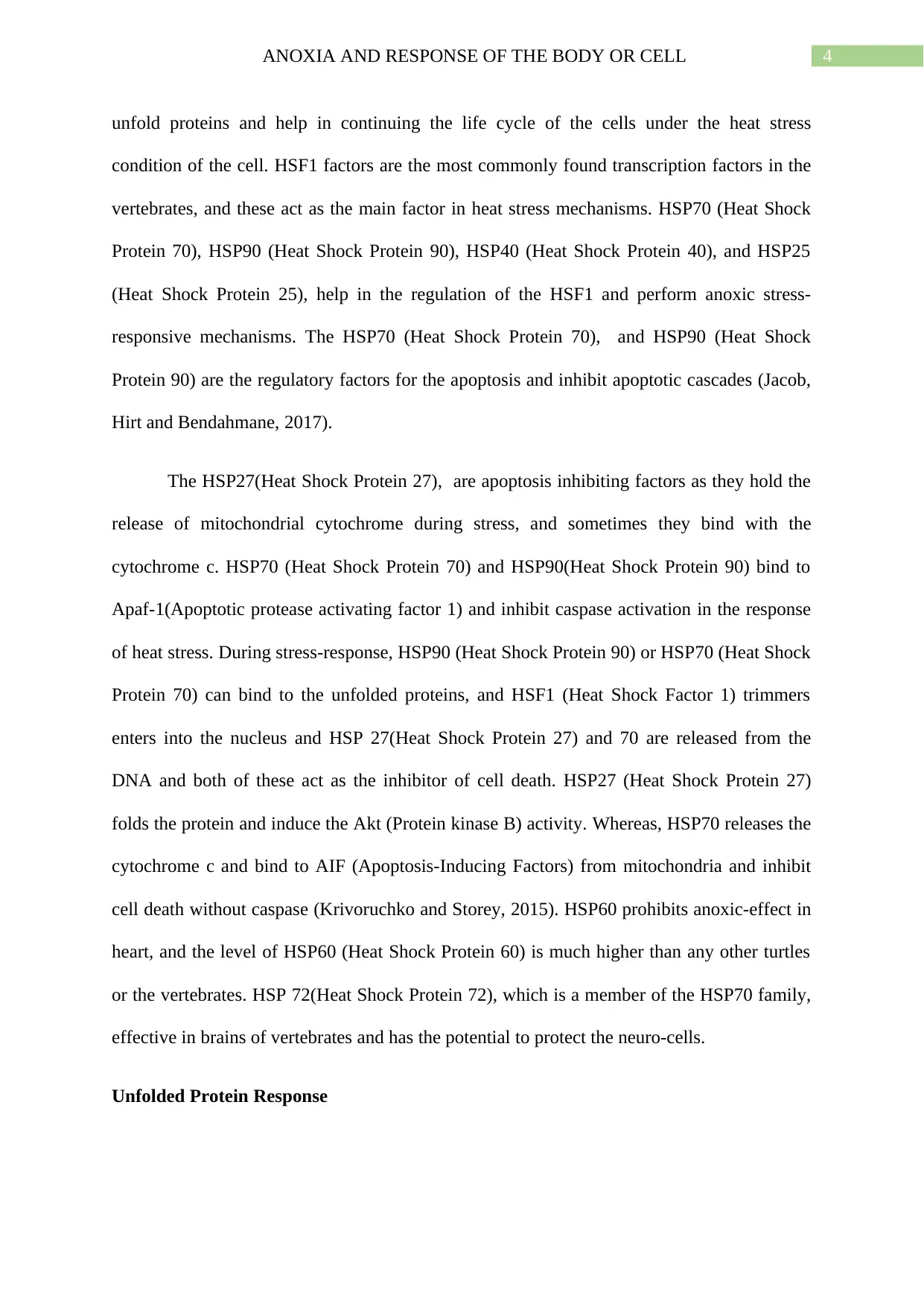
4ANOXIA AND RESPONSE OF THE BODY OR CELL
unfold proteins and help in continuing the life cycle of the cells under the heat stress
condition of the cell. HSF1 factors are the most commonly found transcription factors in the
vertebrates, and these act as the main factor in heat stress mechanisms. HSP70 (Heat Shock
Protein 70), HSP90 (Heat Shock Protein 90), HSP40 (Heat Shock Protein 40), and HSP25
(Heat Shock Protein 25), help in the regulation of the HSF1 and perform anoxic stress-
responsive mechanisms. The HSP70 (Heat Shock Protein 70), and HSP90 (Heat Shock
Protein 90) are the regulatory factors for the apoptosis and inhibit apoptotic cascades (Jacob,
Hirt and Bendahmane, 2017).
The HSP27(Heat Shock Protein 27), are apoptosis inhibiting factors as they hold the
release of mitochondrial cytochrome during stress, and sometimes they bind with the
cytochrome c. HSP70 (Heat Shock Protein 70) and HSP90(Heat Shock Protein 90) bind to
Apaf-1(Apoptotic protease activating factor 1) and inhibit caspase activation in the response
of heat stress. During stress-response, HSP90 (Heat Shock Protein 90) or HSP70 (Heat Shock
Protein 70) can bind to the unfolded proteins, and HSF1 (Heat Shock Factor 1) trimmers
enters into the nucleus and HSP 27(Heat Shock Protein 27) and 70 are released from the
DNA and both of these act as the inhibitor of cell death. HSP27 (Heat Shock Protein 27)
folds the protein and induce the Akt (Protein kinase B) activity. Whereas, HSP70 releases the
cytochrome c and bind to AIF (Apoptosis-Inducing Factors) from mitochondria and inhibit
cell death without caspase (Krivoruchko and Storey, 2015). HSP60 prohibits anoxic-effect in
heart, and the level of HSP60 (Heat Shock Protein 60) is much higher than any other turtles
or the vertebrates. HSP 72(Heat Shock Protein 72), which is a member of the HSP70 family,
effective in brains of vertebrates and has the potential to protect the neuro-cells.
Unfolded Protein Response
unfold proteins and help in continuing the life cycle of the cells under the heat stress
condition of the cell. HSF1 factors are the most commonly found transcription factors in the
vertebrates, and these act as the main factor in heat stress mechanisms. HSP70 (Heat Shock
Protein 70), HSP90 (Heat Shock Protein 90), HSP40 (Heat Shock Protein 40), and HSP25
(Heat Shock Protein 25), help in the regulation of the HSF1 and perform anoxic stress-
responsive mechanisms. The HSP70 (Heat Shock Protein 70), and HSP90 (Heat Shock
Protein 90) are the regulatory factors for the apoptosis and inhibit apoptotic cascades (Jacob,
Hirt and Bendahmane, 2017).
The HSP27(Heat Shock Protein 27), are apoptosis inhibiting factors as they hold the
release of mitochondrial cytochrome during stress, and sometimes they bind with the
cytochrome c. HSP70 (Heat Shock Protein 70) and HSP90(Heat Shock Protein 90) bind to
Apaf-1(Apoptotic protease activating factor 1) and inhibit caspase activation in the response
of heat stress. During stress-response, HSP90 (Heat Shock Protein 90) or HSP70 (Heat Shock
Protein 70) can bind to the unfolded proteins, and HSF1 (Heat Shock Factor 1) trimmers
enters into the nucleus and HSP 27(Heat Shock Protein 27) and 70 are released from the
DNA and both of these act as the inhibitor of cell death. HSP27 (Heat Shock Protein 27)
folds the protein and induce the Akt (Protein kinase B) activity. Whereas, HSP70 releases the
cytochrome c and bind to AIF (Apoptosis-Inducing Factors) from mitochondria and inhibit
cell death without caspase (Krivoruchko and Storey, 2015). HSP60 prohibits anoxic-effect in
heart, and the level of HSP60 (Heat Shock Protein 60) is much higher than any other turtles
or the vertebrates. HSP 72(Heat Shock Protein 72), which is a member of the HSP70 family,
effective in brains of vertebrates and has the potential to protect the neuro-cells.
Unfolded Protein Response
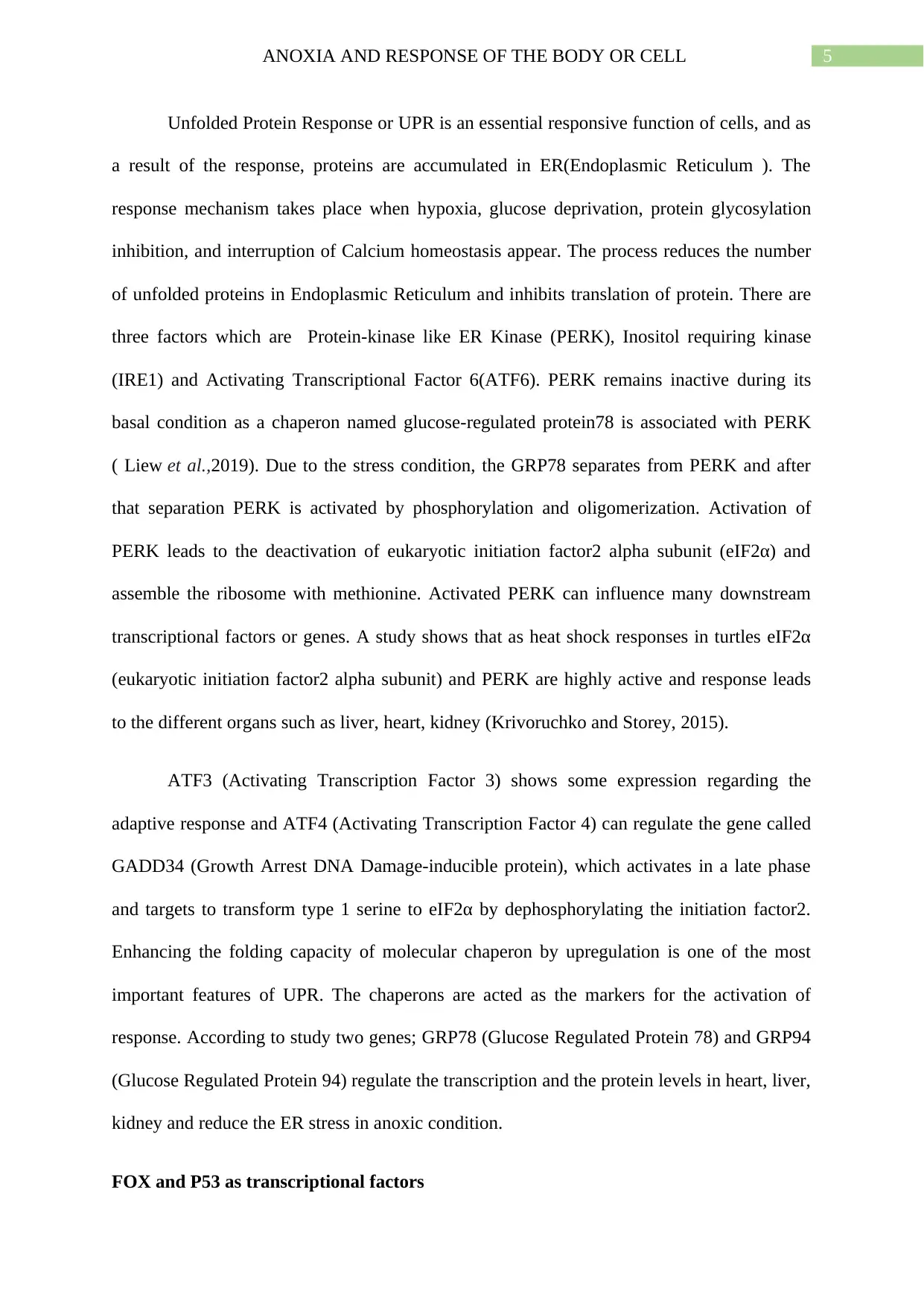
5ANOXIA AND RESPONSE OF THE BODY OR CELL
Unfolded Protein Response or UPR is an essential responsive function of cells, and as
a result of the response, proteins are accumulated in ER(Endoplasmic Reticulum ). The
response mechanism takes place when hypoxia, glucose deprivation, protein glycosylation
inhibition, and interruption of Calcium homeostasis appear. The process reduces the number
of unfolded proteins in Endoplasmic Reticulum and inhibits translation of protein. There are
three factors which are Protein-kinase like ER Kinase (PERK), Inositol requiring kinase
(IRE1) and Activating Transcriptional Factor 6(ATF6). PERK remains inactive during its
basal condition as a chaperon named glucose-regulated protein78 is associated with PERK
( Liew et al.,2019). Due to the stress condition, the GRP78 separates from PERK and after
that separation PERK is activated by phosphorylation and oligomerization. Activation of
PERK leads to the deactivation of eukaryotic initiation factor2 alpha subunit (eIF2α) and
assemble the ribosome with methionine. Activated PERK can influence many downstream
transcriptional factors or genes. A study shows that as heat shock responses in turtles eIF2α
(eukaryotic initiation factor2 alpha subunit) and PERK are highly active and response leads
to the different organs such as liver, heart, kidney (Krivoruchko and Storey, 2015).
ATF3 (Activating Transcription Factor 3) shows some expression regarding the
adaptive response and ATF4 (Activating Transcription Factor 4) can regulate the gene called
GADD34 (Growth Arrest DNA Damage-inducible protein), which activates in a late phase
and targets to transform type 1 serine to eIF2α by dephosphorylating the initiation factor2.
Enhancing the folding capacity of molecular chaperon by upregulation is one of the most
important features of UPR. The chaperons are acted as the markers for the activation of
response. According to study two genes; GRP78 (Glucose Regulated Protein 78) and GRP94
(Glucose Regulated Protein 94) regulate the transcription and the protein levels in heart, liver,
kidney and reduce the ER stress in anoxic condition.
FOX and P53 as transcriptional factors
Unfolded Protein Response or UPR is an essential responsive function of cells, and as
a result of the response, proteins are accumulated in ER(Endoplasmic Reticulum ). The
response mechanism takes place when hypoxia, glucose deprivation, protein glycosylation
inhibition, and interruption of Calcium homeostasis appear. The process reduces the number
of unfolded proteins in Endoplasmic Reticulum and inhibits translation of protein. There are
three factors which are Protein-kinase like ER Kinase (PERK), Inositol requiring kinase
(IRE1) and Activating Transcriptional Factor 6(ATF6). PERK remains inactive during its
basal condition as a chaperon named glucose-regulated protein78 is associated with PERK
( Liew et al.,2019). Due to the stress condition, the GRP78 separates from PERK and after
that separation PERK is activated by phosphorylation and oligomerization. Activation of
PERK leads to the deactivation of eukaryotic initiation factor2 alpha subunit (eIF2α) and
assemble the ribosome with methionine. Activated PERK can influence many downstream
transcriptional factors or genes. A study shows that as heat shock responses in turtles eIF2α
(eukaryotic initiation factor2 alpha subunit) and PERK are highly active and response leads
to the different organs such as liver, heart, kidney (Krivoruchko and Storey, 2015).
ATF3 (Activating Transcription Factor 3) shows some expression regarding the
adaptive response and ATF4 (Activating Transcription Factor 4) can regulate the gene called
GADD34 (Growth Arrest DNA Damage-inducible protein), which activates in a late phase
and targets to transform type 1 serine to eIF2α by dephosphorylating the initiation factor2.
Enhancing the folding capacity of molecular chaperon by upregulation is one of the most
important features of UPR. The chaperons are acted as the markers for the activation of
response. According to study two genes; GRP78 (Glucose Regulated Protein 78) and GRP94
(Glucose Regulated Protein 94) regulate the transcription and the protein levels in heart, liver,
kidney and reduce the ER stress in anoxic condition.
FOX and P53 as transcriptional factors
⊘ This is a preview!⊘
Do you want full access?
Subscribe today to unlock all pages.

Trusted by 1+ million students worldwide
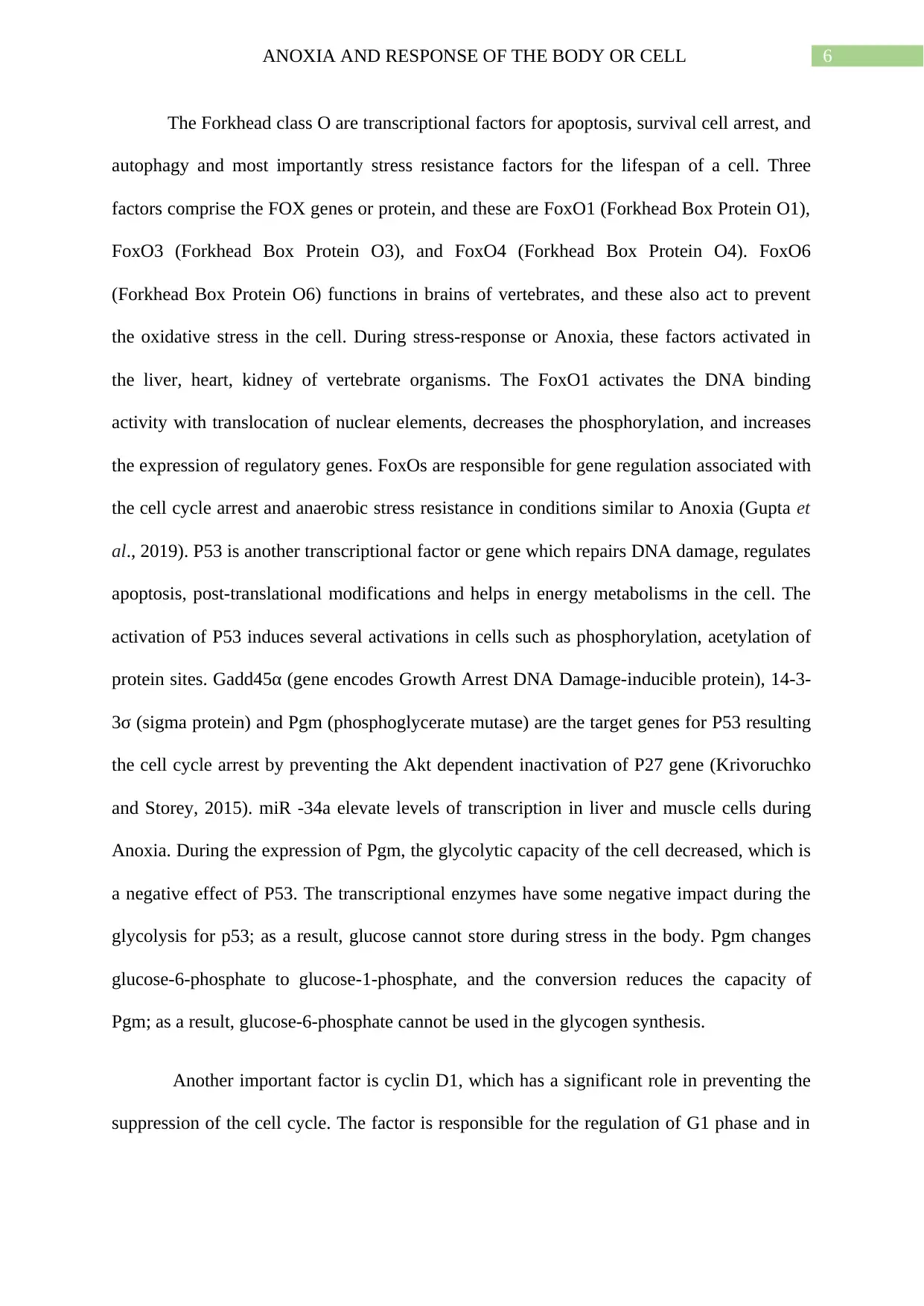
6ANOXIA AND RESPONSE OF THE BODY OR CELL
The Forkhead class O are transcriptional factors for apoptosis, survival cell arrest, and
autophagy and most importantly stress resistance factors for the lifespan of a cell. Three
factors comprise the FOX genes or protein, and these are FoxO1 (Forkhead Box Protein O1),
FoxO3 (Forkhead Box Protein O3), and FoxO4 (Forkhead Box Protein O4). FoxO6
(Forkhead Box Protein O6) functions in brains of vertebrates, and these also act to prevent
the oxidative stress in the cell. During stress-response or Anoxia, these factors activated in
the liver, heart, kidney of vertebrate organisms. The FoxO1 activates the DNA binding
activity with translocation of nuclear elements, decreases the phosphorylation, and increases
the expression of regulatory genes. FoxOs are responsible for gene regulation associated with
the cell cycle arrest and anaerobic stress resistance in conditions similar to Anoxia (Gupta et
al., 2019). P53 is another transcriptional factor or gene which repairs DNA damage, regulates
apoptosis, post-translational modifications and helps in energy metabolisms in the cell. The
activation of P53 induces several activations in cells such as phosphorylation, acetylation of
protein sites. Gadd45α (gene encodes Growth Arrest DNA Damage-inducible protein), 14-3-
3σ (sigma protein) and Pgm (phosphoglycerate mutase) are the target genes for P53 resulting
the cell cycle arrest by preventing the Akt dependent inactivation of P27 gene (Krivoruchko
and Storey, 2015). miR -34a elevate levels of transcription in liver and muscle cells during
Anoxia. During the expression of Pgm, the glycolytic capacity of the cell decreased, which is
a negative effect of P53. The transcriptional enzymes have some negative impact during the
glycolysis for p53; as a result, glucose cannot store during stress in the body. Pgm changes
glucose-6-phosphate to glucose-1-phosphate, and the conversion reduces the capacity of
Pgm; as a result, glucose-6-phosphate cannot be used in the glycogen synthesis.
Another important factor is cyclin D1, which has a significant role in preventing the
suppression of the cell cycle. The factor is responsible for the regulation of G1 phase and in
The Forkhead class O are transcriptional factors for apoptosis, survival cell arrest, and
autophagy and most importantly stress resistance factors for the lifespan of a cell. Three
factors comprise the FOX genes or protein, and these are FoxO1 (Forkhead Box Protein O1),
FoxO3 (Forkhead Box Protein O3), and FoxO4 (Forkhead Box Protein O4). FoxO6
(Forkhead Box Protein O6) functions in brains of vertebrates, and these also act to prevent
the oxidative stress in the cell. During stress-response or Anoxia, these factors activated in
the liver, heart, kidney of vertebrate organisms. The FoxO1 activates the DNA binding
activity with translocation of nuclear elements, decreases the phosphorylation, and increases
the expression of regulatory genes. FoxOs are responsible for gene regulation associated with
the cell cycle arrest and anaerobic stress resistance in conditions similar to Anoxia (Gupta et
al., 2019). P53 is another transcriptional factor or gene which repairs DNA damage, regulates
apoptosis, post-translational modifications and helps in energy metabolisms in the cell. The
activation of P53 induces several activations in cells such as phosphorylation, acetylation of
protein sites. Gadd45α (gene encodes Growth Arrest DNA Damage-inducible protein), 14-3-
3σ (sigma protein) and Pgm (phosphoglycerate mutase) are the target genes for P53 resulting
the cell cycle arrest by preventing the Akt dependent inactivation of P27 gene (Krivoruchko
and Storey, 2015). miR -34a elevate levels of transcription in liver and muscle cells during
Anoxia. During the expression of Pgm, the glycolytic capacity of the cell decreased, which is
a negative effect of P53. The transcriptional enzymes have some negative impact during the
glycolysis for p53; as a result, glucose cannot store during stress in the body. Pgm changes
glucose-6-phosphate to glucose-1-phosphate, and the conversion reduces the capacity of
Pgm; as a result, glucose-6-phosphate cannot be used in the glycogen synthesis.
Another important factor is cyclin D1, which has a significant role in preventing the
suppression of the cell cycle. The factor is responsible for the regulation of G1 phase and in
Paraphrase This Document
Need a fresh take? Get an instant paraphrase of this document with our AI Paraphraser

7ANOXIA AND RESPONSE OF THE BODY OR CELL
the activation of cell proliferation (Liu et al., 2016). Presence of cyclin D1 in both protein
and nuclear fraction helps to reduce the response of body during Anoxia.
NF-κB – an anoxia tolerance factor
NF-κB is one of the significant stress stimulus and transcriptional factor of the stress
response. However, the factor controls many genes related to stress response, cell growth,
immune response, apoptosis, and antioxidant defense (Gölz et al., 2015). The factor has some
significances, for example; elevation of the tolerance in anoxic stress by inducing the level of
phosphorylation of IκB. Another function of the factor is to defend the antioxidant level and
to increase the lifespan of the cell. Ferritin, an antioxidant gene, reduces the possibilities of
the activation of hydroxyl radical by Fenton reaction and increases the transcriptional level of
three proteins related to the factor. The factor helps in the inhibition of apoptosis by two
methods such as mitochondrial pathway and death receptor pathways by controlling anti-
apoptotic genes such as Bcl-xL (B-cell lymphoma extra-large)and Bcl-2 (B-cell Lymphoma 2
gene).
Impact of the physiological process
Impact of anoxia can associate with the glycolysis as interruption of oxygen supply
gives rise to the condition related to glycolytic control (Bundgaard et al.,2019). According to
a study, mole rats can survive for 18 minutes in the total absence of oxygen devoid of any
injuries. This could be possible as the lactate produced in the brain of the mole rats by
fructose metabolism and glycolytic metabolisms. PFK or phosphofructokinase
phosphorylates the fructose or glucose as the result of feedback inhibition. The
phosphofructokinase and inhibition mechanism can bind with the adenosine triphosphate and
downstream intermediate genes, which incorporates carbons from fructose in the glycolytic
the activation of cell proliferation (Liu et al., 2016). Presence of cyclin D1 in both protein
and nuclear fraction helps to reduce the response of body during Anoxia.
NF-κB – an anoxia tolerance factor
NF-κB is one of the significant stress stimulus and transcriptional factor of the stress
response. However, the factor controls many genes related to stress response, cell growth,
immune response, apoptosis, and antioxidant defense (Gölz et al., 2015). The factor has some
significances, for example; elevation of the tolerance in anoxic stress by inducing the level of
phosphorylation of IκB. Another function of the factor is to defend the antioxidant level and
to increase the lifespan of the cell. Ferritin, an antioxidant gene, reduces the possibilities of
the activation of hydroxyl radical by Fenton reaction and increases the transcriptional level of
three proteins related to the factor. The factor helps in the inhibition of apoptosis by two
methods such as mitochondrial pathway and death receptor pathways by controlling anti-
apoptotic genes such as Bcl-xL (B-cell lymphoma extra-large)and Bcl-2 (B-cell Lymphoma 2
gene).
Impact of the physiological process
Impact of anoxia can associate with the glycolysis as interruption of oxygen supply
gives rise to the condition related to glycolytic control (Bundgaard et al.,2019). According to
a study, mole rats can survive for 18 minutes in the total absence of oxygen devoid of any
injuries. This could be possible as the lactate produced in the brain of the mole rats by
fructose metabolism and glycolytic metabolisms. PFK or phosphofructokinase
phosphorylates the fructose or glucose as the result of feedback inhibition. The
phosphofructokinase and inhibition mechanism can bind with the adenosine triphosphate and
downstream intermediate genes, which incorporates carbons from fructose in the glycolytic
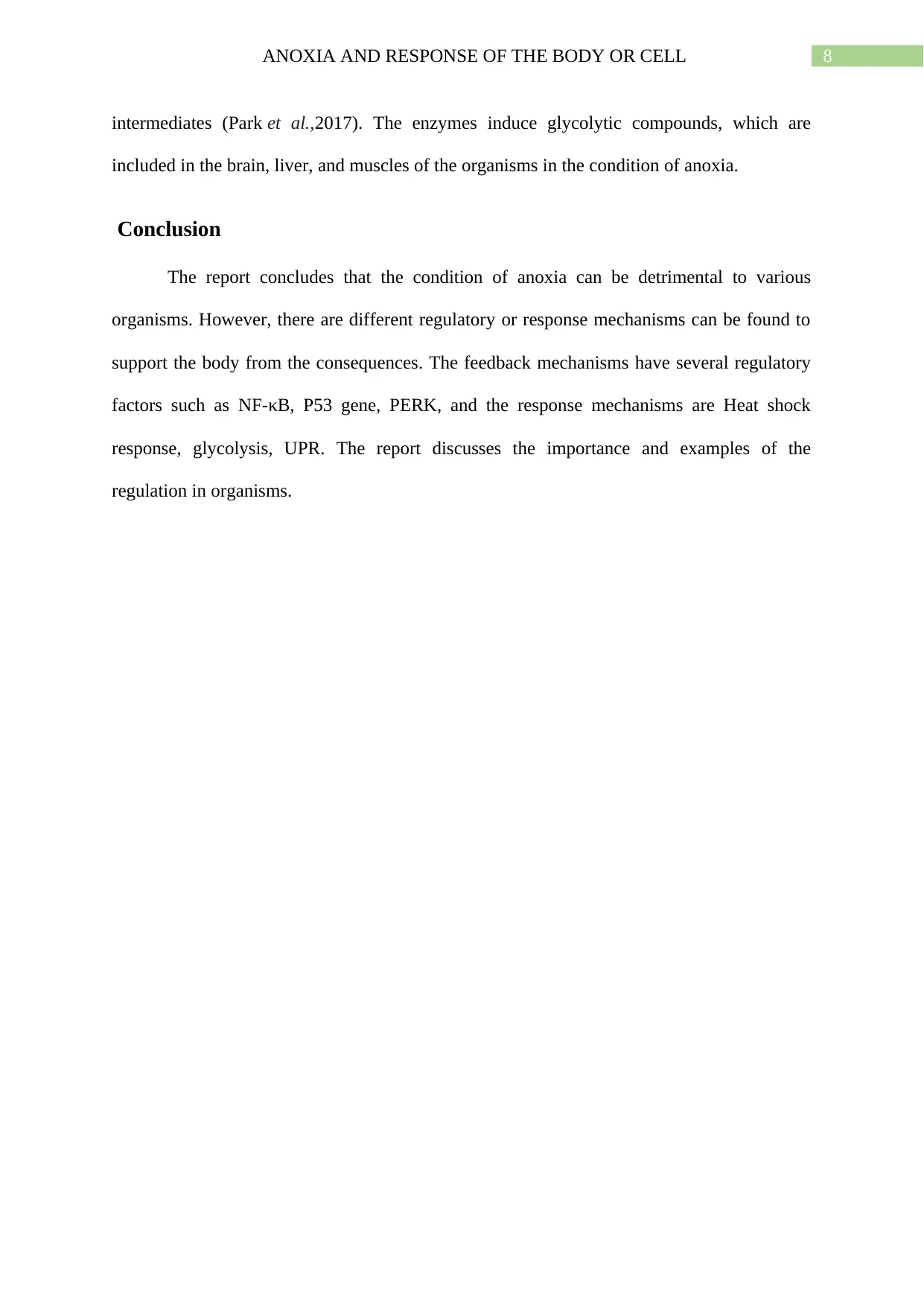
8ANOXIA AND RESPONSE OF THE BODY OR CELL
intermediates (Park et al.,2017). The enzymes induce glycolytic compounds, which are
included in the brain, liver, and muscles of the organisms in the condition of anoxia.
Conclusion
The report concludes that the condition of anoxia can be detrimental to various
organisms. However, there are different regulatory or response mechanisms can be found to
support the body from the consequences. The feedback mechanisms have several regulatory
factors such as NF-κB, P53 gene, PERK, and the response mechanisms are Heat shock
response, glycolysis, UPR. The report discusses the importance and examples of the
regulation in organisms.
intermediates (Park et al.,2017). The enzymes induce glycolytic compounds, which are
included in the brain, liver, and muscles of the organisms in the condition of anoxia.
Conclusion
The report concludes that the condition of anoxia can be detrimental to various
organisms. However, there are different regulatory or response mechanisms can be found to
support the body from the consequences. The feedback mechanisms have several regulatory
factors such as NF-κB, P53 gene, PERK, and the response mechanisms are Heat shock
response, glycolysis, UPR. The report discusses the importance and examples of the
regulation in organisms.
⊘ This is a preview!⊘
Do you want full access?
Subscribe today to unlock all pages.

Trusted by 1+ million students worldwide
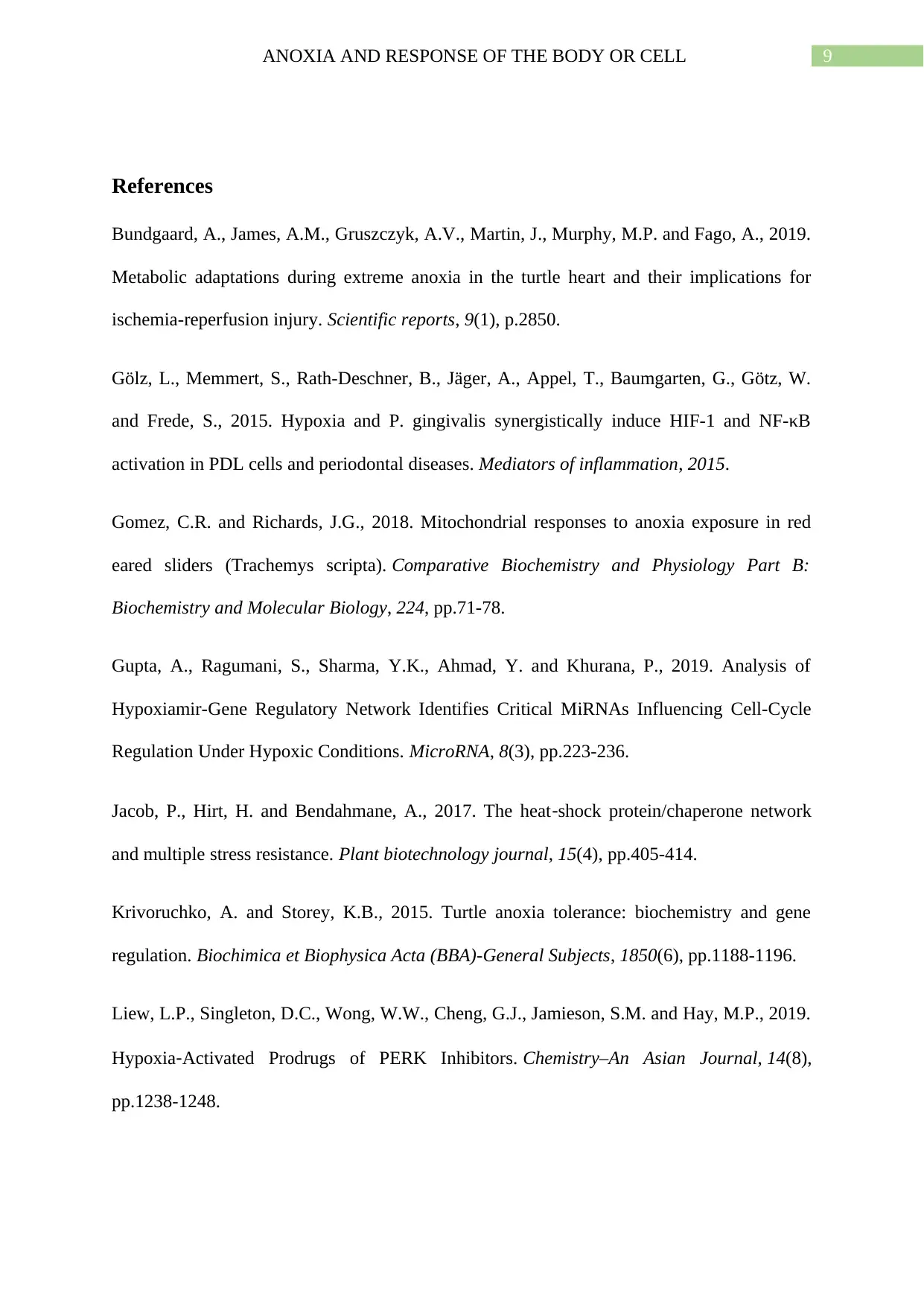
9ANOXIA AND RESPONSE OF THE BODY OR CELL
References
Bundgaard, A., James, A.M., Gruszczyk, A.V., Martin, J., Murphy, M.P. and Fago, A., 2019.
Metabolic adaptations during extreme anoxia in the turtle heart and their implications for
ischemia-reperfusion injury. Scientific reports, 9(1), p.2850.
Gölz, L., Memmert, S., Rath-Deschner, B., Jäger, A., Appel, T., Baumgarten, G., Götz, W.
and Frede, S., 2015. Hypoxia and P. gingivalis synergistically induce HIF-1 and NF-κB
activation in PDL cells and periodontal diseases. Mediators of inflammation, 2015.
Gomez, C.R. and Richards, J.G., 2018. Mitochondrial responses to anoxia exposure in red
eared sliders (Trachemys scripta). Comparative Biochemistry and Physiology Part B:
Biochemistry and Molecular Biology, 224, pp.71-78.
Gupta, A., Ragumani, S., Sharma, Y.K., Ahmad, Y. and Khurana, P., 2019. Analysis of
Hypoxiamir-Gene Regulatory Network Identifies Critical MiRNAs Influencing Cell-Cycle
Regulation Under Hypoxic Conditions. MicroRNA, 8(3), pp.223-236.
Jacob, P., Hirt, H. and Bendahmane, A., 2017. The heat‐shock protein/chaperone network
and multiple stress resistance. Plant biotechnology journal, 15(4), pp.405-414.
Krivoruchko, A. and Storey, K.B., 2015. Turtle anoxia tolerance: biochemistry and gene
regulation. Biochimica et Biophysica Acta (BBA)-General Subjects, 1850(6), pp.1188-1196.
Liew, L.P., Singleton, D.C., Wong, W.W., Cheng, G.J., Jamieson, S.M. and Hay, M.P., 2019.
Hypoxia‐Activated Prodrugs of PERK Inhibitors. Chemistry–An Asian Journal, 14(8),
pp.1238-1248.
References
Bundgaard, A., James, A.M., Gruszczyk, A.V., Martin, J., Murphy, M.P. and Fago, A., 2019.
Metabolic adaptations during extreme anoxia in the turtle heart and their implications for
ischemia-reperfusion injury. Scientific reports, 9(1), p.2850.
Gölz, L., Memmert, S., Rath-Deschner, B., Jäger, A., Appel, T., Baumgarten, G., Götz, W.
and Frede, S., 2015. Hypoxia and P. gingivalis synergistically induce HIF-1 and NF-κB
activation in PDL cells and periodontal diseases. Mediators of inflammation, 2015.
Gomez, C.R. and Richards, J.G., 2018. Mitochondrial responses to anoxia exposure in red
eared sliders (Trachemys scripta). Comparative Biochemistry and Physiology Part B:
Biochemistry and Molecular Biology, 224, pp.71-78.
Gupta, A., Ragumani, S., Sharma, Y.K., Ahmad, Y. and Khurana, P., 2019. Analysis of
Hypoxiamir-Gene Regulatory Network Identifies Critical MiRNAs Influencing Cell-Cycle
Regulation Under Hypoxic Conditions. MicroRNA, 8(3), pp.223-236.
Jacob, P., Hirt, H. and Bendahmane, A., 2017. The heat‐shock protein/chaperone network
and multiple stress resistance. Plant biotechnology journal, 15(4), pp.405-414.
Krivoruchko, A. and Storey, K.B., 2015. Turtle anoxia tolerance: biochemistry and gene
regulation. Biochimica et Biophysica Acta (BBA)-General Subjects, 1850(6), pp.1188-1196.
Liew, L.P., Singleton, D.C., Wong, W.W., Cheng, G.J., Jamieson, S.M. and Hay, M.P., 2019.
Hypoxia‐Activated Prodrugs of PERK Inhibitors. Chemistry–An Asian Journal, 14(8),
pp.1238-1248.
Paraphrase This Document
Need a fresh take? Get an instant paraphrase of this document with our AI Paraphraser

10ANOXIA AND RESPONSE OF THE BODY OR CELL
Liu, Z.J., Liu, H.L., Zhou, H.C. and Wang, G.C., 2016. TIPE2 inhibits hypoxia-induced
Wnt/β-catenin pathway activation and EMT in glioma cells. Oncology Research Featuring
Preclinical and Clinical Cancer Therapeutics, 24(4), pp.255-261.
Park, T.J., Reznick, J., Peterson, B.L., Blass, G., Omerbašić, D., Bennett, N.C., Kuich, P.H.J.,
Zasada, C., Browe, B.M., Hamann, W. and Applegate, D.T., 2017. Fructose-driven glycolysis
supports anoxia resistance in the naked mole-rat. Science, 356(6335), pp.307-311.
Liu, Z.J., Liu, H.L., Zhou, H.C. and Wang, G.C., 2016. TIPE2 inhibits hypoxia-induced
Wnt/β-catenin pathway activation and EMT in glioma cells. Oncology Research Featuring
Preclinical and Clinical Cancer Therapeutics, 24(4), pp.255-261.
Park, T.J., Reznick, J., Peterson, B.L., Blass, G., Omerbašić, D., Bennett, N.C., Kuich, P.H.J.,
Zasada, C., Browe, B.M., Hamann, W. and Applegate, D.T., 2017. Fructose-driven glycolysis
supports anoxia resistance in the naked mole-rat. Science, 356(6335), pp.307-311.
1 out of 11
Your All-in-One AI-Powered Toolkit for Academic Success.
+13062052269
info@desklib.com
Available 24*7 on WhatsApp / Email
![[object Object]](/_next/static/media/star-bottom.7253800d.svg)
Unlock your academic potential
Copyright © 2020–2025 A2Z Services. All Rights Reserved. Developed and managed by ZUCOL.


